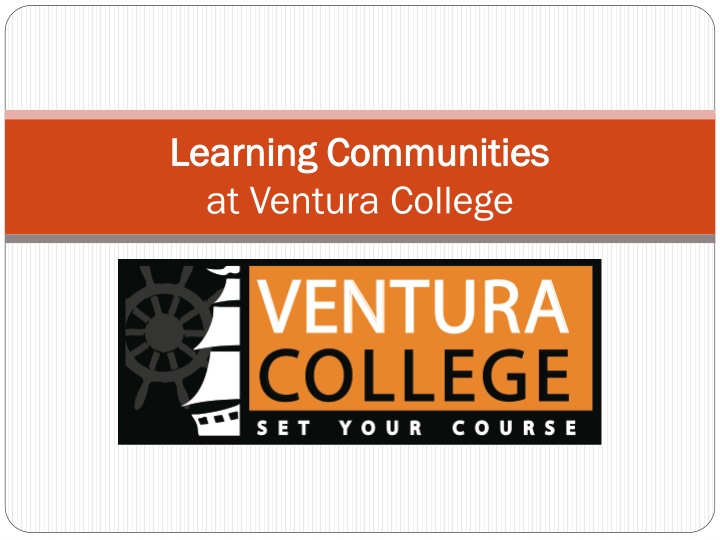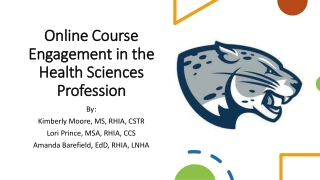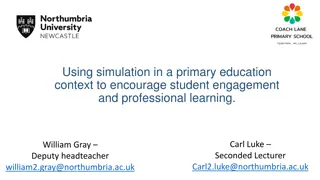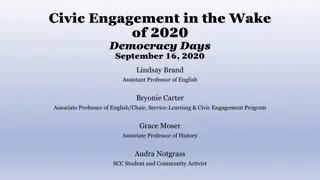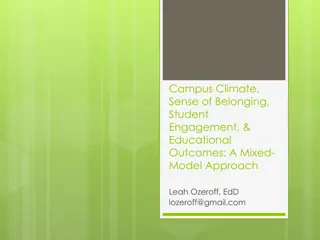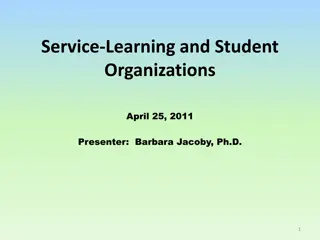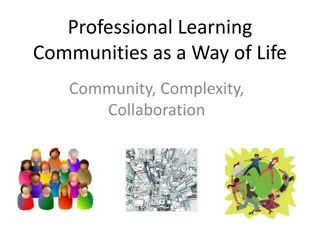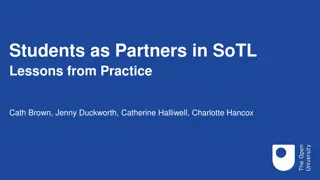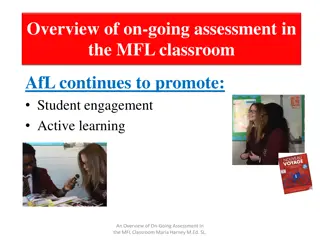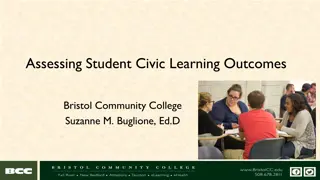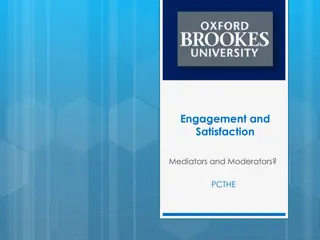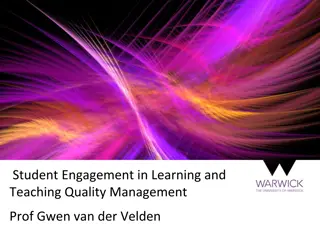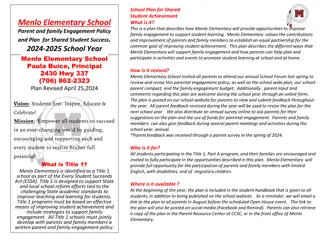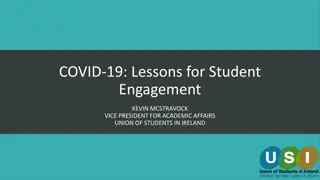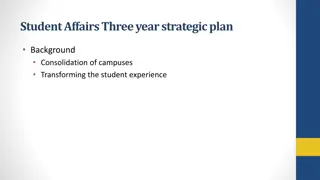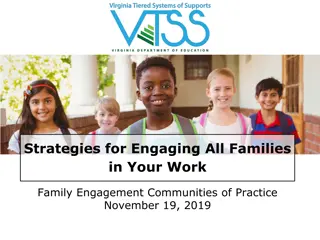Importance of Learning Communities for Student Engagement
Learning communities at Ventura College offer a unique interdisciplinary learning environment that fosters a sense of community among students. Various course configurations, learning cohorts, and opportunities for active and collaborative learning contribute to enhanced student engagement and academic success. Explore the impact of Ventura College's learning communities through student surveys and benchmark scores on aspects like collaborative learning, student effort, and academic challenge.
Uploaded on Mar 02, 2025 | 1 Views
Download Presentation

Please find below an Image/Link to download the presentation.
The content on the website is provided AS IS for your information and personal use only. It may not be sold, licensed, or shared on other websites without obtaining consent from the author.If you encounter any issues during the download, it is possible that the publisher has removed the file from their server.
You are allowed to download the files provided on this website for personal or commercial use, subject to the condition that they are used lawfully. All files are the property of their respective owners.
The content on the website is provided AS IS for your information and personal use only. It may not be sold, licensed, or shared on other websites without obtaining consent from the author.
E N D
Presentation Transcript
Learning Communities Learning Communities at Ventura College
What are learning communities? Interdisciplinary learning Importance of sense of community for learning Student engagement Various course configurations possible Learning cohorts VC s Learning Communities Committee
Community College 2010 Survey of Student Engagement, Ventura College
Ventura College Fall 2011 Ventura College Fall 2011 Learning Communities Student Survey Learning Communities Student Survey VC Learning Communities Average of 22 Colleges with Learning Communities 37.9 % Reporting More Memorizing facts and figures 32.7 59.8 Analyzing elements of an idea, experience, or theory 61.4 58.8 Thinking through my assumptions 54.5 58.2 Synthesizing ideas, experiences, or theories 65.3 59.8 Evaluating information, methods, and arguments 63.4 59.5 Integrating ideas, strategies, and skills from multiple sources 57.4 55.2 Applying theories or concepts to practical problems or new situations 57.4
CCSSE benchmark 1: CCSSE benchmark 1: Active Active and Collaborative and Collaborative Learning (VC score is (VC score is 46.8% In my learning community, I: Learning 46.8%) ) 49.5% Ask questions in class: 62.4% Participate in class discussions or seminars: 76.3% Work on reading, writing and/or problem-solving assignments during class: Work with other students to solve problems or examine complex issues during class: Peer review my and other students work during class: 85.2% 82.2% 79.2% Work with other students on group projects during class: 74.3% Present my work, or work done as part of a group, to the class:
CCSSE Benchmark #2: Student Effort (VC score is 46.4%) Student Effort My participation in this learning community helps me to develop my ability to: 77.2% Persist when faced with academically challenging work: 91.1% Take responsibility for my own learning: 90.1% Be successful in future courses and programs:
CCSSE Benchmark #3: Academic Challenge (VC score is 47.5%) Academic Challenge My participation in this learning community helps me to develop my ability to: Write clearly and effectively 85.2% Speak clearly and effectively 83.2% Think critically and analytically 83.0% Analyze quantitative problems 76.2%
CCSSE Benchmark #4: Student Student- -Faculty Interaction Faculty Interaction (VC score is 47.2%) My participation in this learning community helps me to develop my ability to: Make all students feel comfortable about participating in class activities: Make all students feel comfortable about participating in class activities: Encourage students to discuss assigned work in class 90.1% 90.1% 92.1 Help students establish productive working groups 85.2 Talk to me about my ideas 78.2
CCSSE Benchmark #4: Student Student- -Faculty Interaction Faculty Interaction (VC score is 47.2%) My participation in this learning community helps me to develop my ability to: (continued) Encourage me to explore my ideas 85.2 Help me use my background knowledge and life experiences to learn new things Demonstrate how to integrate concepts and skills from different classes in a meaningful way Assign work that asks me to connect concepts and skills from different classes to reach new understanding and/or applications 80.2 71.3 76.3
CCSSE Benchmark #4: Student Student- -Faculty Interaction Faculty Interaction (VC score is 47.2%) My participation in this learning community helps me to develop my ability to: (continued) Show me how to evaluate the strengths and weaknesses in my work as a basis for improvement Encourage me to seek out other resources on campus (library, math center, writing center, learning center, student services, financial aid, etc.) Encourage me to plan the next steps in my education with a counselor or advisor 77.2 83.1 67.3
CCSSE Benchmark #5: Support for Learners (VC score is 49.6%) Support for Learners My participation in this learning community helps me to develop my ability to: Take responsibility for my own learning 91.1 Be successful in future courses and programs 90.1
STUDENT SURVEY HIGHLIGHTS FROM THE 2010-11 SURVEYS Faculty activities or behaviors that were reported by students to happen often or very often included the following: 89% reported that their teachers encouraged them to ask questions in class. 88% of the respondents reported that their teachers made students feel comfortable about participating in class activities. 86% reported that their teachers encouraged them to discuss assigned work in class. 80% of the respondents reported that teachers made the goals, objectives, and vocabulary of learning communities clear. Exceptionally high student outcomes included the following: 92% of the respondents reported that they were expected to take responsibility for their own learning often or very often in the learning community. 89% reported that in their learning community they were required to think critically and analytically often (38%) or very often (51%).
CCSSE vs. Learning Community CCSSE Question In your experience at this college during the current school year, about how often have you put together ideas or concepts from different courses when completing assignments or during class discussions? 55% responded often or very often Ventura College Learning Community Survey Question Teachers in my learning community demonstrate how to integrate concepts and skills from different classes in a meaningful way. 71.3 responded often or very often In my learning community, compared to other classes, I spend more, less, or about the same amount of time integrating ideas, strategies, and skills from multiple sources. 57.4% said they did this more in the learning community
